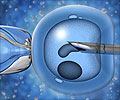According to Researchers Men produce more mutant sperm as they get older and they found to their surprise that some of these mutations give the
According to Researchers Men produce more mutant sperm as they get older and they found to their surprise that some of these mutations give the sperm an edge.
The deformed sperm increase the risk of disease in the men's offspring, but nonetheless are likely to beat out their healthy counterparts in the race to fertilize the egg, the researchers said.The research team was trying to explain why a rare genetic disease called Apert syndrome is more common in children born to older fathers. Apert syndrome is marked by webbed fingers and early fusion of the skull bones, which must be surgically corrected.
Researchers were looking for two mutations that cause virtually all cases of Apert syndrome. "For some reason, a sperm with one of these mutations is more likely to be used to make a baby than normal sperm," said researchers.
The researchers studied sperm from 148 men aged 21 to 80. Most of the men did not have children with Apert syndrome but 15 of the men did. The two mutations that cause most cases of Apert syndrome affect a gene and the protein it controls called fibroblast growth-factor receptor-2. Men over 60 were three times as likely as men under 30 to have sperm with at least one of these changes. The mutations were found only in sperm -- which men make freshly daily -- and not in the blood.
In men with Apert children, the younger men were more likely to have the mutation than the older men.
"Men over age 52 are six times more likely than a 27-year-old to have a child with Apert syndrome, so the mutation rate alone can't account for the condition's link to paternal age" said Researchers.
Literally hundreds of millions of sperm are made in each batch, so in most cases there are still many normal sperm available. Because the few mutated sperm are more likely to be used to make a baby than would be expected, the mutation must provide them some competitive advantage over their normal counterparts.








